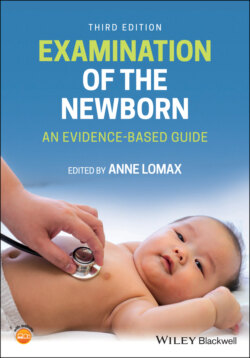Читать книгу Examination of the Newborn - Группа авторов - Страница 2
Table of Contents
Оглавление1 Cover
2 Title Page
3 Copyright Page
4 List of contributors
5 Acknowledgements
6 Introduction Political drivers for examination of the newborn – past and present Ensuring best practice The UK National Screening Committee Key documents SMaRT 4 NIPE Third edition Examination of the Newborn: An Evidence‐Based Guide – what’s new? REFERENCES
7 About the companion website
8 CHAPTER 1: HISTORY TAKING AND THE NEWBORN EXAMINATION Introduction Objectives and characteristics of good history taking Building a history profile: where to start? Evaluation of maternal medical records: biophysical information The NHS Antenatal Screening Programme Risk factors and the newborn examination Parental dialogue and involvement with the newborn assessment process Interpretation of the information Importance of location for the newborn examination Limitations to history taking Conclusion REFERENCES
9 CHAPTER 2: Cardiovascular and respiratory assessment of the baby Introduction Development of the lungs Development of the heart Transition to extrauterine life Fetal circulation Postnatal circulation Respiratory considerations Impact of hypoglycaemia, hypoxia and hypothermia on transitional events In summary Examination of the cardiovascular and respiratory systems Examination of the heart Examination of the respiratory system Examination of the chest Conclusion Look here for resources on congenital heart defects REFERENCES
10 CHAPTER 3: The neonatal skin: examination of the jaundiced newborn Introduction Physiology and development Assessment of the neonatal skin Care of the neonatal skin: a consistent approach to practice Common skin lesions in the neonate Examination of the jaundiced newborn Acknowledgements Look here for resources on neonatal infection and management of jaundice REFERENCES
11 CHAPTER 4: Examination of the head, neck and eyes Examination of the head and neck Examination of the head Examination of the neck Examination of the eye Conclusion Look here for resources on tongue‐tie REFERENCES
12 CHAPTER 5: Assessment of gestational age and newborn reflexes Introduction Assessment of gestational age Neurological state of the newborn Newborn reflexes Growth charts Conclusion Look here for resources on gestational age and reflexes REFERENCES
13 CHAPTER 6: Examination of the newborn abdomen and genitalia Examination of the newborn abdomen Examination of the newborn genitalia Conclusion Acknowledgements Look here for resources on undescended testes and hypospadias REFERENCES
14 CHAPTER 7: Developmental dysplasia of the hip and abnormalities of the foot Developmental dysplasia of the hip Abnormalities of the foot Conclusion Look here for resources on congenital knee abnormalities and examination of the hips Glossary of terms REFERENCES
15 CHAPTER 8: Chromosomal and genetic problems: giving feedback to parents Background Useful genetic terminology Modes of inheritance Antenatal screening Antenatal ultrasound Postnatal screening via the newborn blood spot test Ways in which actual or suspected genetic or chromosomal anomalies may present on the newborn check Commoner specific genetic and chromosomal disorders Gene disorders Feedback to the parents in cases of congenital abnormality Conclusion Look here for resources on Mowat–Wilson syndrome REFERENCES
16 CHAPTER 9: Newborn behaviours: supporting parents to develop early attachments Introduction Fetal development Maternal–fetal attachment Attachment theory How can health professionals promote parent–infant bonding? The parents Feedback to parents The concept of behavioural states Consoling strategies The newborn infant’s smile Behaviours indicating sensitivity and stress Preparations before the newborn examination Describing newborn behaviour during the examination Documentation Postgraduate training Conclusion Look here for resources on understanding neonatal behaviour REFERENCES
17 CHAPTER 10: Examination of the newborn: professional issues in practice Introduction Newborn and infant physical examination standards and Programme Handbook Significant Influences Affecting Professional Competency and Conduct The neonatal examination: competence for practice The Code and the newborn examination process Consent in practice Confidentiality in practice Role of the employer Local policies to direct practice Risk management SMaRT 4 NIPE (S4N) The newborn examination practitioner: education and competence Integration of NIPE training into the undergraduate pre‐registration curriculum New NMC standards for midwifery education Recommendations for practice –keeping up to date Conclusion Look here for resources on dealing with professional issues surrounding the newborn examination REFERENCES
18 APPENDIX 1: A step‐by‐step guide to examination of the newborn Step one Step two Step three Step four Step five Step six Step seven Step eight Step nine Step ten Look here for additional resources to help with this process
19 APPENDIX 2: Useful website addresses Chromosomal and genetic problems
20 Index
21 End User License Agreement
